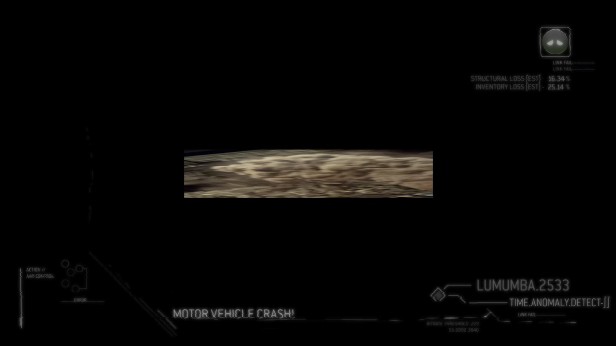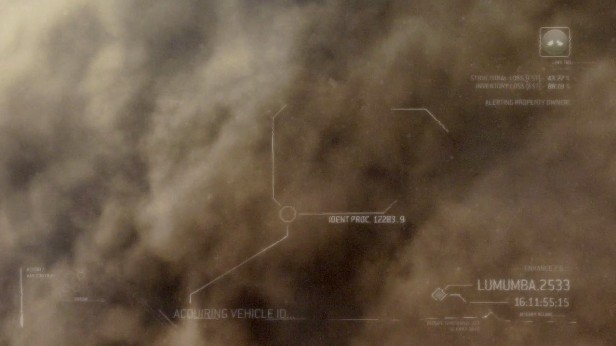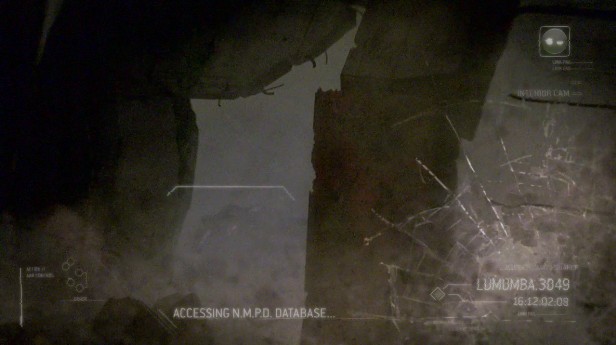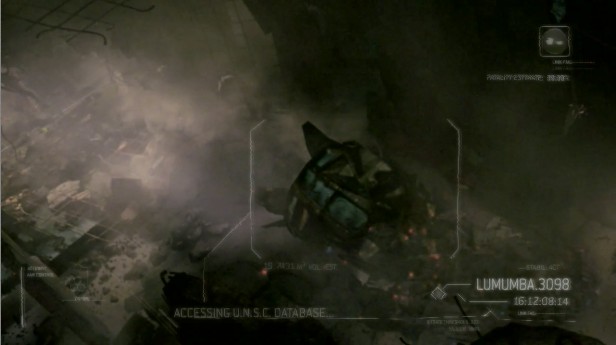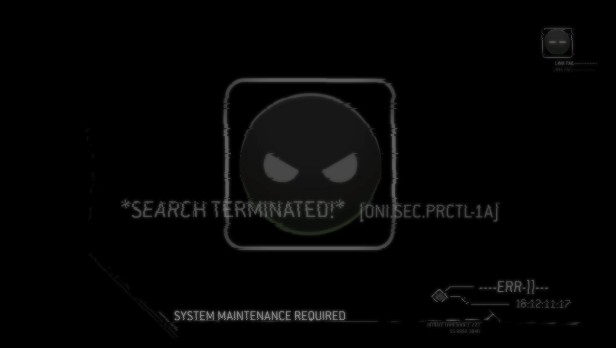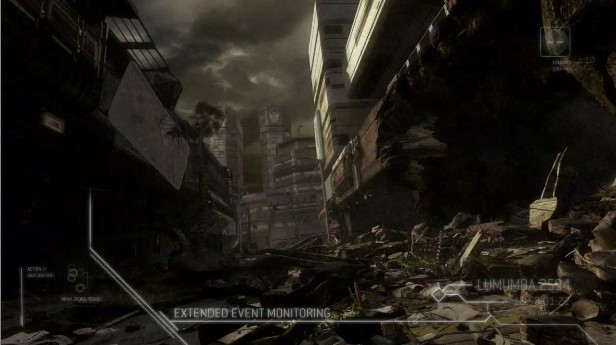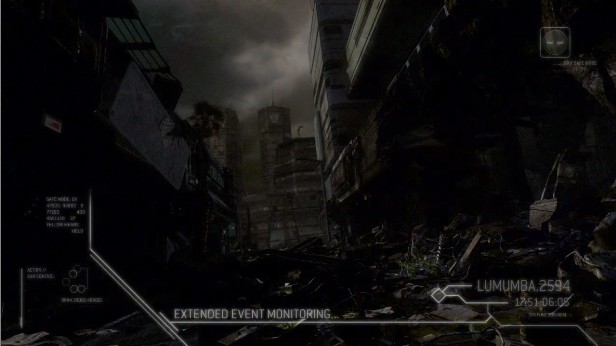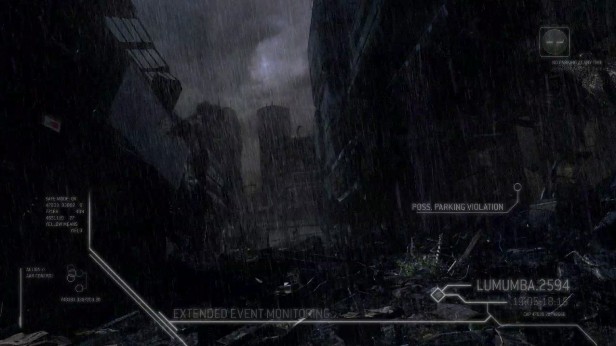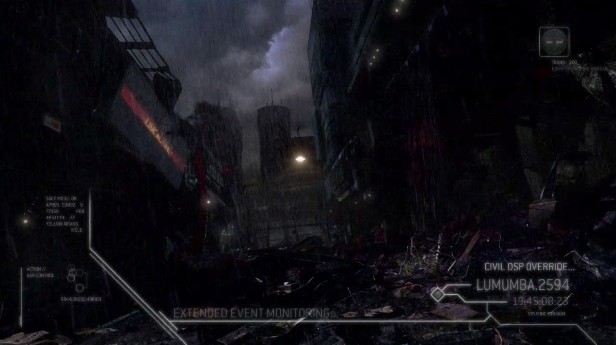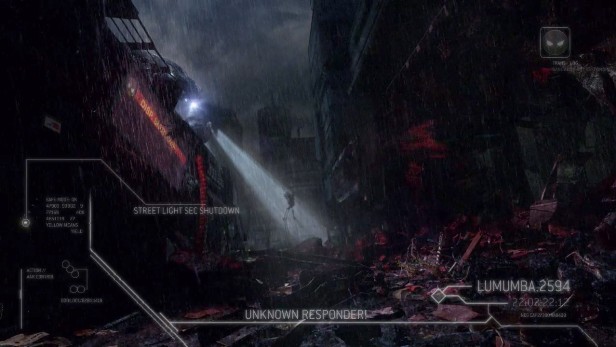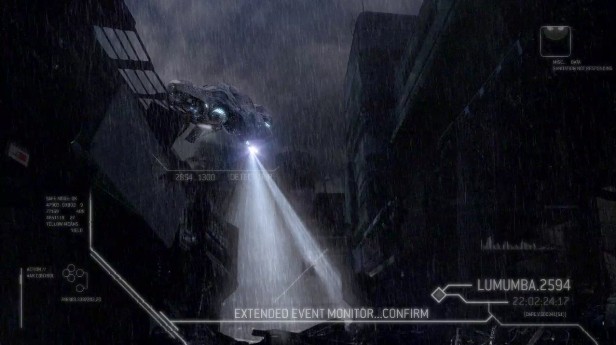The Golden Hour (Part 1)
The new teaser opens exactly how the first video did. The first forty-eight seconds are identical to the first teaser – however, at the point at which the final, single drop pod impacted with the camera in the first video, our viewpoint changes to a street-level camera, in the Lumumba sector.
We only get a moment’s view of the alleyway, but it is long enough to note a few things: the street is littered with debris, a fire rages in the distance, and a thick plume of smoke towers in the skyline. Paper and trash float down to the street.
The destruction of the city makes sense: the Covenant – specifically, Regret’s fleet – have invaded and ravaged the streets; the city has subsequently been evacuated. There is at least one, however, who remains, and it is this being that tracks the drop pod’s progress. And as the pod crashes through the buildings on the street, this being – the Superintendent of New Mombasa – mistakenly labels it as a “motor vehicle crash!” Well, it was a vehicle that crashed into the side of a building at street-level.
The clock at the bottom right of the screen, as you may recall, increased its rate of speed immediately after the slipspace event; we theorized that Regret’s method of departure caused an “anomaly,” in time. The debris overtakes the camera, and it cuts to black. At this moment, the text at the bottom of the camera reveals something to us:
As you can see, the words “TIME ANOMALY DETECT-” appear, and are immediately followed by “RESYNC.GMT” which presumably means that the Superintendent is discounting his own timekeeping statistics and resyncing with Greenwich Mean Time, which is often used when referring to Coordinated Universal Time, the standard for timekeeping on Earth; the anomaly caused by the slipspace event briefly disrupted the flow of time in New Mombasa, and the Superintendent defers to an outside source to correctly identify the current time.
Our view switches to a top-down camera, and a large cloud of dust is rising into the air from the drop pod’s crash site. At this moment, a number of statistics come up on the heads-up display of the Lumumba-region camera.
The most obvious of these is the one at the bottom of the screen – “FATALITY ESTIMATE: 99.99%” This tells us two things: firstly, that the Superintendent recognizes the object as some type of human transport (though the “motor vehicle” label casts doubt that the SI realizes that it is an HEV), and secondly, it also assumes the death of its occupant due to the nature of its landing – though they can sustain heavy damage, these drop pods are certainly not meant to crash through multiple buildings at the end of their journey.
The other set of numbers on the screen are less important – percentages indicating structural loss, as well as estimating the loss of inventory in one of the buildings involved with the crash. The percentages rise and then peak, followed by a message indicating that the “property owner” is being alerted. If he’s still alive, I doubt he’ll be surprised by the message.
At this point, the Superintendent begins attempting to identify the fallen HEV. He scrolls through multiple protocols, while digitally enhancing the image in an effort to catch a glimpse of the pod through the thick dust. All the while, multiple messages flash on the camera, indicating a loss of link with an unknown source, as well as a “NO COM LOCK” message, which likely means that the drop pod was scanned for a COM signal.
The A.I.’s efforts are fruitless, however, as its standard protocols fail and it is unable to identify the craft. It switches to a damaged interior camera, changes protocols, and begins accessing a new database.
“N.M.P.D.” most likely refers to the New Mombasa Police Department, which, besides the A.I.’s own internal databases, would be the next reasonable place to search for something help it identify this visitor from above. This is the first we’ve heard of a local police department, but it stands to reason that even during wartime, each city still requires a functioning police force. After all, even after the Human-Covenant war began, the human rebel activity that the Spartans were originally trained to deal with continued.
You may also notice that the Superintendent’s expression has changed. From what could be interpreted as sadness, it has now switched to an expression of inquiry.
A few notices appear on the HUD, one reading “TERTIARY ACQ SYS” and another one: “CC DAMAGE.” These are immediately followed by another, “CIVIL CC OVERRIDE,” and finally, “NO MATCH” in reference to the Superintendent’s search of the N.M.P.D. database.
The A.I. switches to yet another camera as it begins its search of a U.N.S.C. database.
Various messages appear on the screen, including, the “FATALITY ESTIMATE: 99.99%” notice, and, briefly, one that reads “STABIL: ACT.” It is unknown what this could be referring to.
After a few moments of searching, something appears very briefly in the bottom right of the screen – “PRIORITY COMM OVERRIDE” and then the screen goes black. Another message appears:
It appears as though the Superintendent does not have the authority to access the information it seeks, under [ONI.SEC.PRCTL-1A], the same protocol which protected the first transmission seen on Bungie.net.
The A.I. does not appear to be happy with this news.
As many have speculated, the letters and numbers seen here most likely refer to ONI Section 1, which, as we have previously mentioned, is the intelligence-gathering division of the Office of Naval Security. The identity, and more importantly, rank, of the person inside of this drop pod is being tightly kept from inquiring minds.
The Superintendent gives up on this search, and switches back to an exterior camera. Something quickly becomes clear – the video that we are seeing is obviously a recording, as many had speculated from the previous teaser. A fast-forward sound can be heard as the environment changes, and the clock in the corner of the HUD accelerates its time-keeping. This is not like the last time the clock accelerated, and yet the action onscreen continued normally – a message onscreen informs us that we are viewing “extended event monitoring,” which is apparently the Superintendent’s terminology for the time-lapse footage that we are currently seeing.
Right as the time-lapse footage begins, a message can be seen onscreen: “DATA CORE OFFLINE [16:02:59]” indicating the time at which the A.I. lost a vital link. At some point, however, during the passage of the next few hours, an uplink of some sort is regained – the “LINK FAIL” notices, which had been situated at various points on the screen, are now replaced with various numbers and letters. System functionality is referred to as “SUB-NOM,” indicating that it is functioning, albeit at a sub-nominal level.
The yellow and bleak skies are replaced with darkness; the wind whispers into the alleyway, and with a sudden flash of lightning, rain begins to fall – watching via the time-lapse footage, the downpour begins eerily instantly.
A frame-by-frame analysis reveals various messages that pop up throughout the duration of the time-lapse footage. One indicates a “street lighting failure.” Another informs us of a “structural engineering code variance.” Another reads: “RECYCLING: DO YOUR PART!” All the while, similarly-themed notices appear at the top right of the screen, all of them reminiscent of the Superintendent’s original communications on the Bungie.net forums. While these messages may seem pointless, we must remember that we are viewing the actions of an “urban infrastructure A.I,” as the first Bungie.net transmission identified it. Even in the wake of a city-wide disaster, the A.I. still must follow its primary purpose – managing the city.
At at least we get a laugh out of it.
At 00:01:17, no less.
Lastly, a message indicating a “signage override” is displayed, and a billboard briefly lights up. This occurs as the same moment that a “CIVIL DSP OVERRIDE” message is displayed at the bottom of the HUD.
Also on the screen can be seen a message on the billboard – “LINK ACTIVE.”
Immediately following this, the uplink that the Superintendent has achieved yields some interesting results – the phrase “SAY MY NAME” is shown at the bottom right of the screen. This is the name of the heavy cruiser that represented half of the communications in the second Bungie.net transmission.
Another interesting message appears a single frame before the next event – the text reads: “RING 801A 80B 320C.” Of course, the word “ring,” immediately draws to mind the Halo Array, although enough information does not currently exist to verify that reference.
The time-lapse footage suddenly slows down, and a searchlight appears at the end of the street. The camera’s HUD indicates a “maintenance interrupt,” and begins alerting the N.M.P.D. Simultaneously, it initiates the shutdown of all sources of light, apparently in an effort to conceal the fact that the A.I. is still functioning. It is interesting that although the Superintendent continues its unimportant messages in such a desolate environment, it also has the capacity to realize and initiate the steps needed to ensure its survival when the environment becomes seemingly hostile.
The Phantom, as it can now be clearly identified, appears to be looking for something, with its searchlights roaming the empty streets. As the Superintendent zooms in on it, something very interesting happens. Simultaneously, a block of text, as well as out-of-place audio can be heard.
The text, seen at the bottom right of the screen, clearly reads: “DARE.V.500.41(S1)” This is the designation of the (presumed to be ONI) Captain that was seen speaking to the Admiral of Say My Name in the second Bungie.net transmission.
The audio could almost be mistaken for gunfire – it sounds very much like bullets being fired. It is, however, most likely a series of bolts being blasted free.
The Superintendent, prioritizing its feed, switches back to an interior camera, and its powerful systems immediately begin processing the data that it is receiving. Based on the audio, it recalculates the previous fatality estimate for the drop pod inhabitant – it now reads at “00.52%” This calculation holds steady, as the pod depressurizes and opens…

